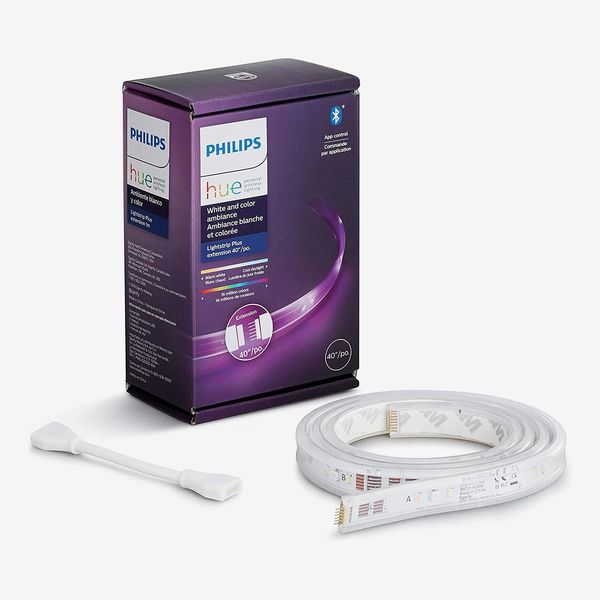
Over this past year of quarantining, I’ve spent a considerable amount of time thinking about how to turn my work-from-home setup into something functional and aesthetically pleasing. I got an external monitor, a TaoTronics desk lamp, a keyboard, and a mouse. That was effective in turning my space into something that at least resembled an office, but it still felt so boring. If I was going to be forced to spend so much time in one spot, at least it could be a little fun.
I started paying attention to other desk setups that I saw online, hoping I could swipe some of their style and make it my own. On tech YouTube and Twitch streams, I noticed lots of people playing with smart light strips, turning their desks into Daft Punk–style, Tron-like mash-ups of alternating colors. Soon after that, it felt like those light strips were all over TikTok, too. And not just on the desks of gamers and keyboard builders. Regular people were doing creative things with them, like making custom RGB clouds for their ceilings using cardboard and cut-up pieces of Poly-fil. In a matter of weeks, the lights were everywhere.
I reached out to a few of the people whose smart-light-adorned setups I admired and asked them how (and why) they used RGB lights. Alexander “Alexotos” Medeot, a Twitch streamer who specializes in building mechanical keyboards, says smart strip lights “add character to your room during streams and videos.” Andy To, a video director and creative director with over 100,000 followers on Instagram and YouTube, picked them up after visiting a friend who was “living within the smarthome atmosphere,” he says. “Everything was interconnected to his iPhone, including the lights.” He bought a couple strips, found them “easy to use — kind of plug and play,” and then bought more. He now has one light strip behind him during streams, multiple strips behind his main computer desk, one behind his TV, and one in his bedroom. The colors he picks depend on his mood: “When I want to concentrate, I hit the bright white lights. When I want to relax and sort of settle down a little bit I’ll change it to warmer colors.”
The idea that these lights could not only look cool but affect your productivity and outlook made sense to me, as I’ve had similar experiences with color-changing smart lights before. When I tested the Philips Hue Play smart lights a few months ago, I used them to light up my room in different colors based on what I was watching. So when The Mandalorian was on, I’d pull out my phone and set the Hue to cast a delicate green color to show my love for Baby Yoda. Or I’d change it to a soft, orangeish-yellow to add some movie-theater atmosphere while rewatching The Sopranos for the 27th time. I liked it enough that I added a Hue bulb to my bedroom, where the first few mornings became spectacles worthy of the opening day of the Olympics. I would tell Siri to turn my lights on and off every few minutes just because I could. When that novelty wore out, I practiced setting the light to different colors depending on what I was doing. After a little experimenting, I learned to turn the light to a calming light orange during my writing sessions, which I found would help me stay focused and limit the number of times I interrupt my progress to check Twitter or find a snack.
Based on what I’ve seen, there is no one way to use these smart light strips. To runs a single strip across the back of his desk; TikTokers run them along their ceilings; and Flossy Carter, a YouTube tech reviewer, installed a set behind his TV so he can change the background color based on the kind of show he’s watching. It’s a simple, immediate, and inexpensive way to improve any space. Here are some of the most popular options.
Philips Hue Smart Lightstrip was recommended by both To and Medeot. The 2m base kit allows you to connect the strips to bed frames, behind computers, or under a desk. You can also sync your games or movies with the lights by using your PC with the Hue Sync app.
If you don’t think 2m worth of smart lights is enough, you can add this extension.
“Strip lights are a nice way to add lighting in difficult-to-reach locations, such as under cabinets, and they can serve as fun accent lighting,” writes Strategist contributor Kyle Schurman. “You can also stick them anyplace a traditional socket and bulb are not available. With the Govee version, it’s easy to change the color and pattern of the lights using voice assistants or apps.”
The Strategist is designed to surface the most useful, expert recommendations for things to buy across the vast e-commerce landscape. Some of our latest conquests include the best acne treatments, rolling luggage, pillows for side sleepers, natural anxiety remedies, and bath towels. We update links when possible, but note that deals can expire and all prices are subject to change.










